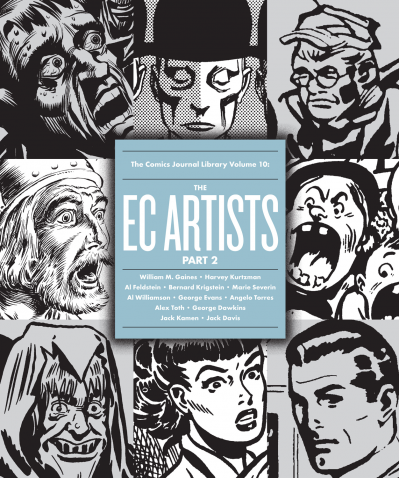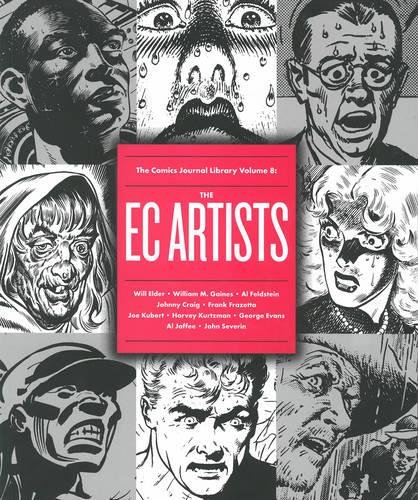
No comics publisher has had a greater impact — or generated more controversy — than the immensely influential EC Comics. The second and concluding volume of conversations with the creators behind the EC war/horror/science fiction/suspense line brings The Comics Journal’s definitive interviews together with several never-before-published sessions, including a new interview with the legendary Jack Davis conducted by Gary Groth. It also includes:
• Publisher Bill Gaines on the origins of the company and his terrifying grilling before the Senate Subcommittee on Juvenile Delinquency.
• Editor/writer/artist Al Feldstein on introducing serious science fiction to comics and his interactions with Ray Bradbury.
• Harvey Kurtzman on bringing realism to war comics with Frontline Combat and subversive satire to humor comics with Mad.
• The master of chirascuro, Alex Toth, on the aesthetic values that guided him through a career that included drawing for EC and animating Jonny Quest.
• Colorist Marie Severin on the atmosphere of pranks and anarchy that dominated the EC bullpen.
Plus, career-spanning interviews with George Evans and Jack Kamen, rare Q&A sessions with formal experimenter Bernard Krigstein and EC writer Colin Dawkins, and a conversation between Jack Davis and award-winning alternative cartoonist Jim Woodring.
• Publisher Bill Gaines on the origins of the company and his terrifying grilling before the Senate Subcommittee on Juvenile Delinquency.
• Editor/writer/artist Al Feldstein on introducing serious science fiction to comics and his interactions with Ray Bradbury.
• Harvey Kurtzman on bringing realism to war comics with Frontline Combat and subversive satire to humor comics with Mad.
• The master of chirascuro, Alex Toth, on the aesthetic values that guided him through a career that included drawing for EC and animating Jonny Quest.
• Colorist Marie Severin on the atmosphere of pranks and anarchy that dominated the EC bullpen.
Plus, career-spanning interviews with George Evans and Jack Kamen, rare Q&A sessions with formal experimenter Bernard Krigstein and EC writer Colin Dawkins, and a conversation between Jack Davis and award-winning alternative cartoonist Jim Woodring.
DOWNLOAD
The Comics Journal Library v10 - The EC Artists 02 (2016) (digital-Empire).cbr
The Comics Journal Library v10 - The EC Artists 02 (2016) (digital-Empire).cbr

The Comics Journal Library series is the most comprehensive series of lavishly illustrated interviews conducted with cartoonists ever published. To celebrate our republication of the legendary EC line, we proudly present the first of a two-volume set of interviews with the artists and writers (and publisher!) who made EC great. Included in the first volume: career-spanning conversations with EC legends Will Elder, John Severin, Harvey Kurtzman, and Al Feldstein, as well as short interviews with EC short-timers Frank Frazetta and Joe Kubert. Also: EC Publisher William Gaines on his infamous Senate subcommittee testimony, and probing conversations between Silver Age cartoonist Gil Kane and Harvey Kurtzman, as well as contemporary alternative cartoonist Sam Henderson and MAD great Al Jaffee. Part of what made EC the best publisher in the history of mainstream comics was some of the most beautiful drawing ever published in comic books, and every interview is profusely illustrated by pertinent examples of the work under discussion.
The Complete Illustrated History of the Skywald [preview pages 1-38].pdf
Hysterical Horror Comic History [In The Dark (2014) (digital)].cbr







































